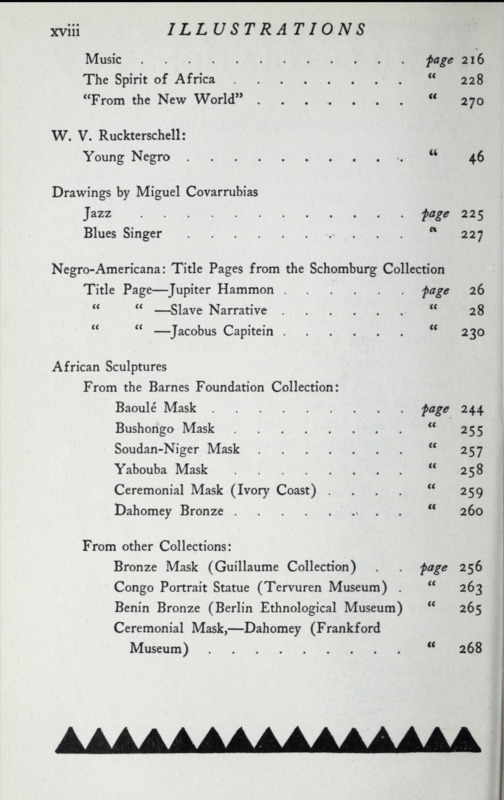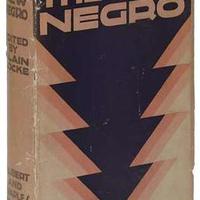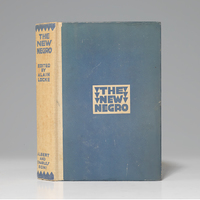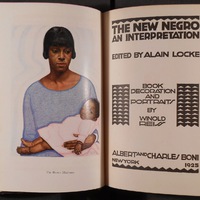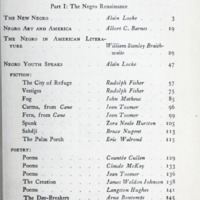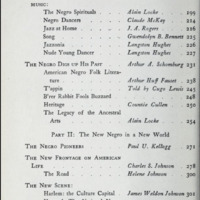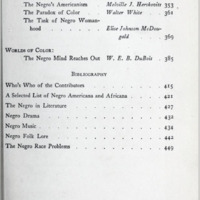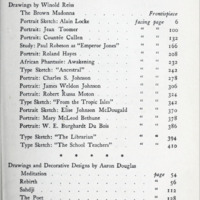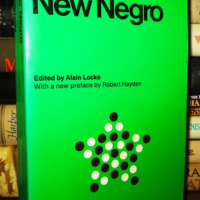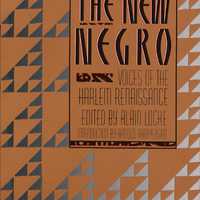New Negro: An Interpretation
Item
-
Title
-
New Negro: An Interpretation
-
This edition
-
"The New Negro: An Interpretation" . Ed. Alain Locke. Portraits by Winold Reiss; illus. Aaron Douglas. New York: A. and C. Boni, 1925. xviii+446 pp.
-
Other editions, reprints, and translations
-
• Repr. New York: Arno, 1968. xviii+446 pp.
• Repr. as "The New Negro". With Preface Robert Hayden. New York: Atheneum, 1968 (hardcover), 1970 (paperback). xxiv+452 pp.
• Repr. Salem, NH: Ayer, 1986. xviii+446 pp.
• Repr. as (on the cover) "The New Negro: Voices of the Harlem Renaissance". with Intro. Arnold Rampersad. New York: Atheneum, 1992. xxxiv+452 pp.; repr. New York: Simon & Schuster, 1997. xxxiv+452 pp. [Google Books limited preview]
-
Google Books (limited preview)
-
Table of contents
-
[Alain Locke] / Foreword (ix)
Part I: The Negro Renaissance
• Alain Locke / The New Negro (3)
• Albert C. Barnes / Negro Art and America (19)
• William Stanley Braithwaite / The Negro in American Literature (29)
• Alain Locke / Negro Youth Speaks (27)
Fiction:
• Rudolph Fisher / The City of Refuge (57)
• Rudolph Fisher / Vesitges (75)
• John Matheus / Fog (85)
• Jean Toomer / Carma (from "Cane") (96)
• Jean Toomer / Fern (from "Cane") (99)
• Zora Neale Hurston / Spunk (105)
• Burce Nugent / Sahdji (113)
• Eric Walrond / The Palm Porch (115)
Poetry:
• Countee Cullen / To a Brown Girl (129)
• Countee Cullen / To a Brown Boy (129)
• Countee Cullen / Tableau (130)
• Countee Cullen / Harlem Wine (130)
• Countee Cullen / She of the Dancing Feet Sings (131)
• Countee Cullen / A Brown Girl Dead (131)
• Countee Cullen / Fruit of the Flower (132)
• Claude McKay / In Memory of Colonel Charles Young (133)
• Claude McKay / Baptism (133)
• Claude McKay / White Houses (134)
• Claude McKay / Like a Strong Tree (134)
• Claude McKay / Russian Cathedral (135)
• Claude McKay / The Tropics in New York (135)
• Jean Toomer / Georgia Dusk (136)
• Jean Toomer / Song of the Son (137)
• James Weldon Johnson / The Creation: A Negro Sermon (138)
• Langston Hughes / The Negro Speaks of Rivers (141)
• Langston Hughes / An Earth Song (142)
• Langston Hughes / Poem [Being walkers with the dawn and morning] (142)
• Langston Hughes / Youth (142)
• Langston Hughes / Song [Lovely, dark, and lonely one] (143)
• Langston Hughes / Dream Variation (143)
• Langston Hughes / Minstrel Man (144)
• Langston Hughes / Our Land (144)
• Langston Hughes / I Too (145)
• Arna Bontemps / The Day-Breakers (145)
• Georgia Douglas Johnson / To Samuel Coleridge Taylor, Upon Hearing His "Sometimes I feel like a motherless child" (146)
• Georgia Douglas Johnson / The Ordeal (146)
• Georgia Douglas Johnson / Escape (147)
• Georgia Douglas Johnson / The Riddle (147)
• Anne Spencer / Lady, Lady (148)
• Angelina Grimke / The Black Finger (148)
• Lewis Alexander / Enchantment (149)
Drama:
• Montgomery Gregory / The Drama of Negro Life (153)
• Jessie Fauset / The Gift of Laughter (161)
• Willis Richardson / Compromise (A Folk Play) (168)
Music:
• Alain Locke / The Negro Spirituals (199)
• Claude McKay / Negro Dancers (214)
• J. A. Rogers / Jazz at Home (216)
• Gwendolyn B. Bennett / Song (225)
• Langston Hughes / Jazzonia (226)
• Langston Hughes / Nude Young Dancer (227)
The Negro Digs Up His Past:
• Arthur A. Schomburg / The Negro Digs Up His Past (231)
• Arthur Huff Fauset / American Negro Folk Literature (238)
• Cugo Lewis / T'appin (Terrapin) (245)
• [Traditional] / B'rer Rabbit Fools Buzzard (248)
• Countee Cullen / Heritage (250)
• Alain Locke / The Legacy of Ancestral Arts (254)
Part II: The New Negro in the New World
• Paul U. Kellogg / The Negro Pioneers (271)
• Charles S. Johnson / The New Frontage on American Life (278)
• Helene Johnson / The Road (300)
The New Scene:
• James Weldon Johnson / Harlem: The Culture Capital (301)
• Kelly Miller / Howard: The National Negro University (312)
• Robert R. Moton / Hampton-Tuskegee: Missioners of the Masses (323)
• E. Franklin Frazier / Durham: Capital of the Black Middle Class (333)
• W. A. Domingo / Gift of the Black Tropics (341)
The Negro and the American Tradition:
• Melville J. Herskovits / The Negro's Americanism (353)
• Walter White / The Paradox of Color (361)
• Elise Johnson McDougald / The Task of Negro Womanhood (369)
Worlds of Color:
• W. E. B. DuBois / The Negro Mind Reaches Out (385)
Bibliography
Who's Who of the Contributors (415)
A Selected List of Negro Americana and Africana (421)
The Negro in Literature (427)
Negro Drama (432)
Negro Music (434)
Negro Folk Lore (442)
The Negro Race Problems (449)
-
About the anthology
-
• Includes 72 pieces by 37 authors, plus extensive bibliographic lists at the end.
-
Anthology editor(s)' discourse
-
• The book is dedicated "To the Younger Generation" (with traditional lyrics: "O, rise, shine for Thy Light is a-coming").
-
Reviews and notices of anthology
-
• n/a
-
Commentary on anthology
-
• Writing in 1930, Robert T. Kerlin lists this anthology as one of the four essential books that would form "the nucleus of a Negro library" and says of it: "This compendious volume, contributed to by some thirty Negroes, might be called an anthology of prose and verse and pictorial art, covering the entire cultural life of the Negro of today" (Robert T. Kerlin. "The Negro's New Cultural Conquest." "Friends Intelligencer" Second Month 15, 1930: 124-26, at 125. [Google Books]
-
Google Books
-
• Use of this anthology in Negro colleges and universities and in Negro schools is mentioned in Thomas L. Dabney's "The Study of the Negro" ("Journal of Negro History" 19.3 [1934], 285, 278-79).
-
• In a 1949 article on Marcus Garvey and the Garveyite movement, Robert H. Brisbane comments on what he sees as the impact of this movement on African American literary culture: "the new place assigned to Africa in the thinking of American Negroes touched off a period of literary creations known as // the Negro Renaissance. "The New Negro", an anthology of Negro verse prepared by the Harvard-educated Alain Locke, appeared in 1925. Books by such outstanding Negroes as Walter White, James Weldon Johnson, Jesse Fauset and Eric Walrond followed. Countee Cullen, Claude McKay and Langston Hughes turned to the Dark Continent for the subjects of new verses. And in answer to the rising demand for literature on Africa and on the black race in general, several Negro scholars began searching in Europe and Africa for out of print books and manuscripts. One of these men, Dr. Arthur Schomburg, founded what today is probably the best collection of works on the Negro race" (Robert H. Brisbane. "His Excellency: The Provincial President of Africa." "Phylon" 10.3 [1949]: 257-64, at 263-64). [See also Mercer Cook 1950, under "The Poetry of the Negro 1746-1949", ed. Hughes and Bontemps.]
-
• The artist Charles Wilbert White (1918-1979) recollects in 1955 the importance of this volume during his teenage years (in the 1930s): White attended Englewood High: "The school had about two thousand pupils, of which about 25% were Negroes. All the teachers, of course, were white. And prejudice was always there." From his voracious reading in the public library, White says he "discovered that the Negro people had played a proud role in history. A book that fascinated me, and opened up new vistas, was Doctor Alain Locke's, "The New Negro." I had never realized that Negro people had done so much in the world of culture, that they had contributed so much to the development of America, that they had even been among the discoverers of the continent. For a while I kept this newfound knowledge to myself. It became a kind of secret life, a new world of facts and ideas in diametric opposition to what was being taught in the classrooms and textbooks as unquestionable truth. But then, the clash began to come out in the open. I would ask my teachers why they never mentioned a Negro in history. . . . When I spoke up about these ignored great figures, I would be told to sit down and shut up. In public speaking classes, whenever I had a chance to speak, it would be about these discoveries of mine. The other Negro students were often embarrassed by this. It had been deeply ingrained in them as in me in my first school years, that to be a Negro was something of which to be ashamed; that the Negro people were an inferior people, illiterate, uncouth. And this was intensified by the clownish role forced upon Negroes in the cinema, by thousands of barbs and shafts in the comic strips, in the newspapers, in casual conversation of white people. Everything characteristic of Negro culture was isolated and distorted into an object of hilarity. And so it was considered best not to mention this embarrassing word or subject. It is a terrible thing, this turning of children against their parents and ancestors, robbing them of their heritage and the riches of their past, leaving them spiritually motherless and fatherless" (Charles White, "The Path of a Negro Artist." "Masses & Mainstream" 8.4 [April 1955]: 33-44, at 34-36) (See also Robert Bone and Richard A. Courage. "The Muse in Bronzeville: African American Creative Expression in Chicago, 1932-1950." New Brunswick, NJ: Rutgers UP, 2011. 148.)
-
• Writing in 1971, John Henrik Clarke remarks: "To the generation that come [sic] to adulthood during the nineteen twenties, this book was revolutionary. In some ways it still is. In the preface to the first edition Alain Locke states the intent of the book as follows: 'This volume aims to document the New Negro culturally and socially,—to register the transformations of the inner and outer life of the Negro in America that have so significantly taken place in the last few years" (John Henrik Clarke. "Twenty Most Important Books by Black Writers." "New York Amsterdam News" 18 Sept. 1971: D21. "ProQuest Historical Newspapers")
-
• Wikipedia entry on this anthology:
-
Wikipedia
-
See also
-
• Locke, Alain. "A Decade of Negro Self Expression." Foreword Howard W. Odum. 1928.
-
Internet Archive
-
• "The New Negro Thirty Years Afterward". Ed. Rayford W. Logan. Washington, DC: Howard UP, 1956. iv+96 pp. (Papers presented at the 16th Annual Spring Conference, 20-22 April 1955, Howard Univ.; "Dedicated to the memory of Professor Alain Locke" with "Bibliography of the Writings of Alain Leroy Locke" by Robert E. Martin, pp. 89-96.)
-
Cited in
-
• Lash 1946: 724.
• Kinnamon 1997: 465. (cites original ed.)
-
Item Number
-
A0017







